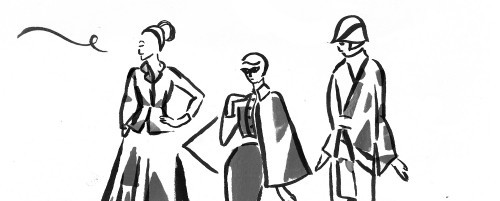Earth Week has given us a lot to celebrate and think about here on campus. We’ve had music, filmmakers and informative speakers all demonstrate how we could limit our impact on the environment.
Earth-friendly style
Earth Week has given us a lot to celebrate and think about here on campus. We’ve had music, filmmakers and informative speakers all demonstrate how we could limit our impact on the environment.

One fun-filled attraction was the N-Show, a runway show which featured models in today’s fashion trends made completely of recycled materials.
Creating clothing out of recycled products is an interesting idea. Yet the notion itself is not a new one, and although many people do not want to wear reconstituted trash, they may be open to other forms of recycling apparel.
Designers are always recycling trends and reusing styles. Staying on trend often means going back in time. This year is no different, with spring fashion for 2012 taking a huge queue from the past.
With maxi dresses and colorful baroque-style gowns walking the runway, the 1970s are back in a major way. Men’s fashion, too, is seeing 1970s tailoring take trousers to new lengths and a revival of ’70s punk fashion. At the same time, fringe, feathers and metallic shine appearing in the fashion magazines indicate a huge nod to 1920s flapper fashion for women.
One great aspect about the retro-inspired looks that are trending right now is that you don’t have to spend a lot of money to recreate them yourself. Clothing from all the trendy styles of the past can be found at your local second hand and vintage stores.
But trend-hunting is not the only reason to shop vintage.
Vintage stores are often locally owned businesses who really value community support and do a great service by providing added personality to their neighborhoods. Plus, buying clothes secondhand is a great way to recycle clothing and reduce your negative personal impact on the environment.
Time Magazine included vintage shopping on their “Global Warming Survival Guide,” which contains 51 ideas on cutting carbon emissions. According to their research, the manufacturing of new clothing can have serious environmental ramifications people might not be aware of.
“Some synthetic textiles are made with petroleum products,” Time reported. “Cotton accounts for less than 3 percent of farmed land globally but consumes about a quarter of the pesticides.”
So, a lot of the time purchasing new clothing is not only trendy, but contributes to the human trend of environmental irresponsibility. That doesn’t mean that in order to help the environment you have to sacrifice personal style and flair, just that purchasing clothing is a more important decision than simply deciding if a garment makes your butt look good.
If you like high end and brand names, you can find them second hand at a fraction of the cost.
The best part about buying vintage is that you find unique items. Unlike shopping at Forever 21 or H&M, shopping vintage gives you the opportunity to find one-of-a-kind things, assuring nobody will be along after you to scoop up the same exact item.
Sometimes it works. Some stores you will go to and it will seem as if every article of clothing was custom fit to your exacting style and specifications. Then the next time you go to the same store they are apparently only selling clothing for very large, retired rodeo clowns.
It is all part of the fun. Sometimes just looking at the different fashions people have worn over the years is like being in a bizarre interactive museum.
If you put some diligence into searching through the vintage racks, you can usually end up with at least one garment that is absolutely perfect. By getting your retro duds tailored, you can create a truly personalized wardrobe which likely still costs less than buying new. That way you look sharp and polished, while also helping to conserve the planet’s resources and reducing your carbon footprint.
And you do not have to stop there. There are a lot of cheap and environmentally sound ways to get new clothes and stay fashionable.
If you have friends, perhaps you can swap clothing with them. Clothing can create totally different effects based on the person wearing it. So your problem clothes or unwanted threads could become your best friend’s new favorite outfit.
If you have parents, aunts, uncles or grandparents that might have saved their 1950s, ’60s and ’70s couture, get them to let you raid their attic.
Places like Buffalo Exchange are great for finding clothing from all fashion trends and styles. Vintage, contemporary and everything in between can be found at “trade-in” shops at prices that are much less than firsthand retail stores. If you’re lucky you can also get them to pay you for your old clothes.
Don’t forget, you can also cycle things around within your own wardrobe. Put some things away for a while, so that they become new to you again. Reconstruct other items by layering, adjusting length, dying or accessorizing.
The best part about fashion is that it is fun, but you can still be environmentally mindful while designing your style.





Excellent article I really enjoyed it. I personally try to purchase clothes from thrift shops but this article has opened up other doors for my wardrobe. The concept of clothes from recycled materials is a new and interesting concept to me. With the threat of our ecosystem, these alternatives would help out and IMO are still fashionable.